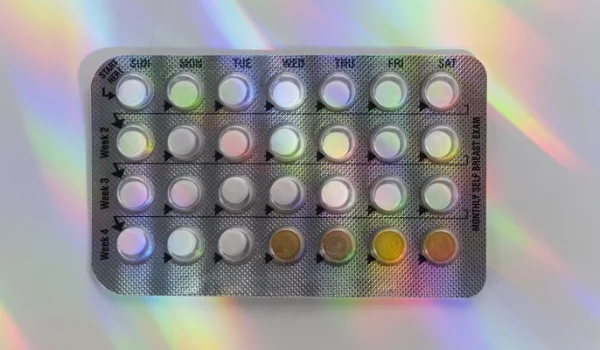-
By: health
-
May 23, 2023
How birth control can be part of gender-affirming care for transmasc and gender-nonbinary folks
TW: Language about birth control and pregnancy is often gendered in ways that aren’t welcoming or inclusive of transgender and gender-nonbinary (TGNB) people. Some TGNB people may prefer specific language to talk about their bodies and body functions, while other TGNB people may find those same words triggering. This article will use the term “bleeding” to refer to periods/menstruation.
Note: This article is focused on the use of birth control for TGNB people with a uterus. For TGNB people whose bodies make sperm, preventing pregnancy in partners may also be an important part of reducing gender dysphoria. Currently, barrier methods, vasectomy, pulling out, and orchiectomy are the only birth control methods available to sperm-producing people.
People of all gender identities use birth control for many different reasons , including pregnancy prevention and stopping or managing bleeding. For some TGNB people, experiencing pregnancy or bleeding could worsen feelings of gender dysphoria. Birth control can help reduce that dysphoria. At the same time, some TGNB people have questions about whether using birth control, especially hormonal methods, might interfere with the effects of testosterone or cause feminizing changes. Here are the facts.
Preventing pregnancy can be gender-affirming
Not everyone knows that TGNB folks can get pregnant while taking testosterone . If being pregnant would worsen gender dysphoria for you, you may want to consider using birth control to prevent pregnancy. Regardless of gender identity or sexual orientation, if you have a body that can become pregnant and you have receptive frontal/vaginal sex with people whose bodies make sperm, you can get pregnant. And while using testosterone can stop bleeding, it’s not a substitute for birth control.
Can birth control stop or reduce bleeding?
Yes. Birth control can be used by people of all gender identities to stop or reduce bleeding. Since frontal/vaginal bleeding can worsen gender dysphoria for some TGNB folks, birth control can be a key part of gender-affirming care. While there are a variety of different medications and procedures that TGNB people can use to stop bleeding, hormonal birth control is often easier to get and use than other options. You can also use birth control to stop or reduce bleeding if you don’t want to take testosterone, can’t take testosterone, or are still having bleeding while taking testosterone. (If you are still having bleeding while taking testosterone, especially if you’ve been on testosterone for more than six months, check in with your health care provider.)
But will it affect my transition?
TLDR: probably not. Some TGNB people are concerned that birth control could cause feminizing changes that don’t fit with their gender identity. There are many different forms of birth control out there, but there are three general types—methods with no hormones, methods with only progestin hormones, and methods with a combination of estrogen and progestin hormones. None of these methods are likely to cause feminizing changes or interfere with testosterone.
Non-hormonal methods
Copper IUDs, spermicide, diaphragms, internal and external condoms, and sterilization are methods that don’t involve any hormones, which means that they can’t cause feminizing changes or interact with testosterone. However, the copper IUD can cause heavier bleeding and cramping for some people. We don’t know for sure if people who aren’t bleeding while they are using testosterone are also at risk for increased bleeding or cramping with a copper IUD. These non-hormonal methods can’t be used to stop or reduce bleeding, but they can help you prevent pregnancy.
Progestin-only methods
The progestin-only pill, shot, implant, and hormonal IUD (and over-the-counter emergency contraception pills) only contain the hormone progestin, which doesn’t interact with testosterone. Additionally, these methods can be used to stop or reduce bleeding. However, progestin-only methods increase the chances that bleeding will be unpredictable in people not taking testosterone. We don’t know for sure if people who use these methods while taking testosterone have the same chances of irregular bleeding as people who don’t take testosterone. Another thing to keep in mind is that progestin-only methods can cause chest or breast tenderness that can worsen gender dysphoria for some people.
Combination estrogen-progestin methods
The patch, ring, and combination pill all contain a combination of estrogen and progestin. These methods are the most effective at stopping bleeding altogether for people not taking testosterone. They’re also less likely to cause the unpredictable bleeding that happens with progestin-only methods. We don’t know yet whether these methods are equally effective in people who are also taking testosterone. Keep in mind that these methods can also cause chest or breast tenderness, especially when you’re starting them, but this usually gets better within the first month or two.
The amount of estrogen in combination estrogen-progestin birth control methods is not enough to cause feminizing changes or prevent the masculinizing effects of testosterone for most people. Even though some people who have trouble accessing health care may use birth control pills as feminizing hormone therapy, this is not recommended by health care providers. That’s because the type of estrogen and progestin used in feminizing hormone therapy are different from the types of hormones used in birth control pills.
A study looking at TGNB people taking combination pills and testosterone did not find increased estrogen levels in the blood. However, there are a few ways that combination methods could interact with testosterone. Combination methods may lower the amount of testosterone produced by the ovaries. For most TGNB folks taking testosterone, the amount of testosterone coming from the ovaries is very small in comparison to the amount of testosterone being taken as gender-affirming hormone therapy. So for most people, this doesn’t have a noticeable impact on their transition.
Combination methods can also increase a protein in the body called sex hormone binding globulin (SHBG). SHBG binds to some of the testosterone in the bloodstream, so less of it is used by the body’s tissues. It is not known if the increase in SHBG is enough to decrease the effects of testosterone taken as gender-affirming hormone therapy. If you notice a decrease in how well your testosterone is working after starting a combination method, talk to your health care provider, and they may adjust your testosterone dose to maintain the same effects.
Bottom line: Birth control can be gender affirming for many TGNB people by preventing pregnancy and stopping bleeding. Neither hormonal nor non-hormonal birth control methods will have a significant impact on the effects of testosterone or create feminizing changes for most people.
It’s always up to you to decide what’s most important when picking a birth control method. Check out the Method Explorer or talk with a health care provider to find a method that’s right for you.









Leave a comment